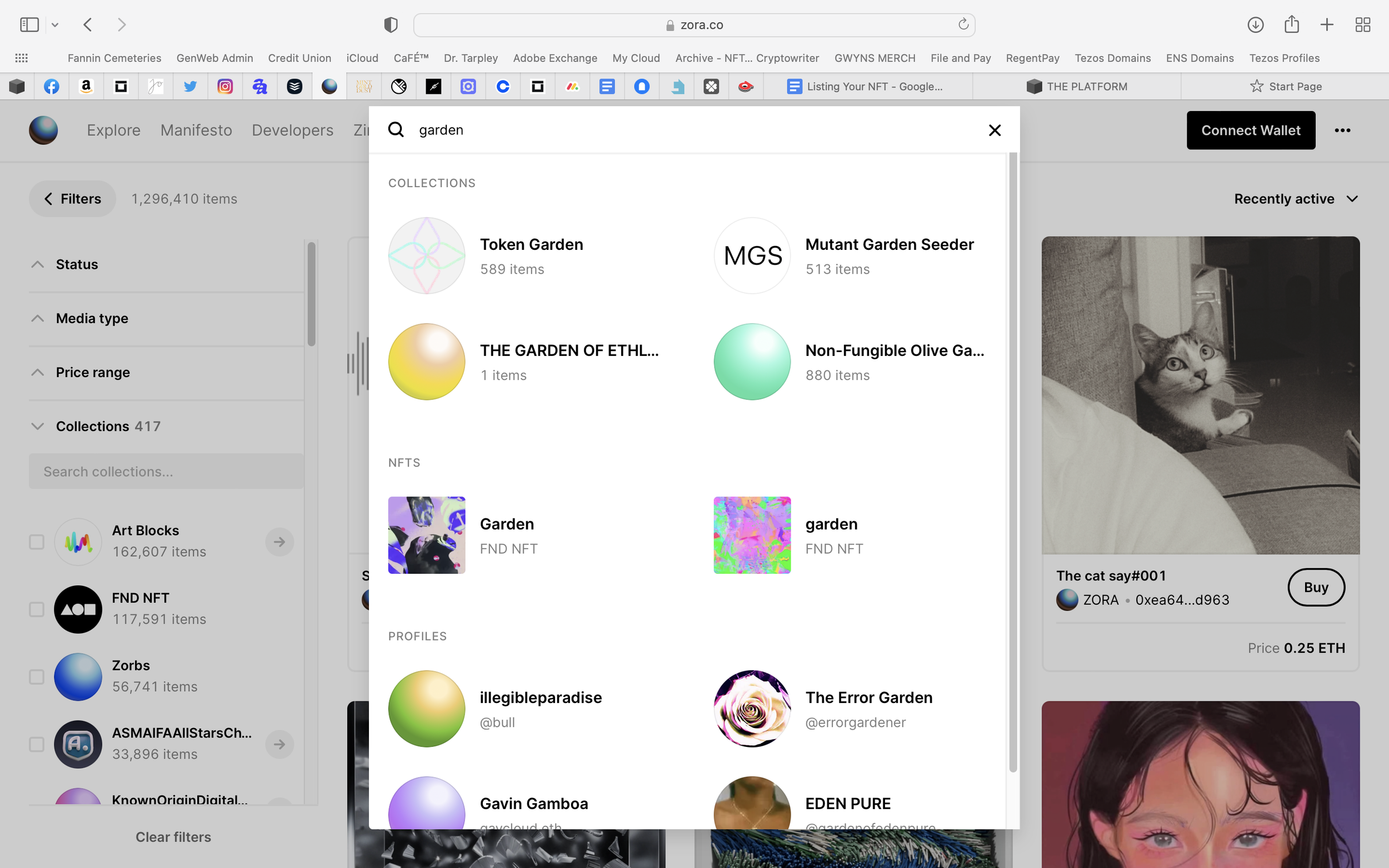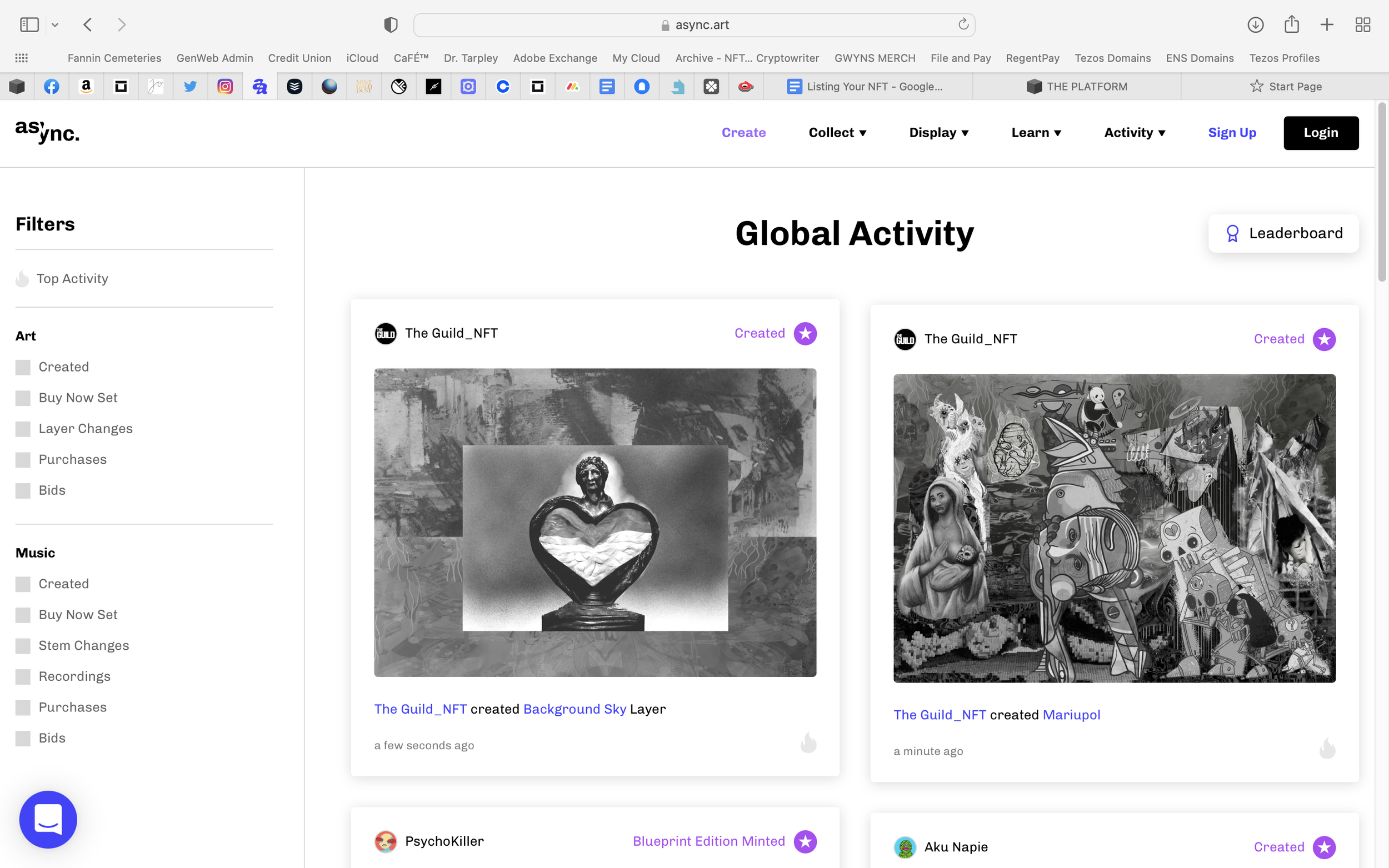LISTING YOUR NFT
From the collection of the author.
APRIL 5TH, 2022
In the first article in this series of three, Selecting an NFT Marketplace, I gave an overview of the points an artist should consider when choosing a platform, and focused particularly on the architectural essentials of the minting transaction. Today I want to go into more detail about the listing of your NFT for sale. In a final article, we’ll focus on showcasing your NFT. In these articles, I write from the perspective of an individual artist offering one of one or limited edition works, though many of the considerations apply equally to creators or collectors of pfp-style projects.
We often find ourselves using a given platform to both mint and list our work, and we often depend on that same platform to showcase our work to the world. However, these are distinct functions that I urge you to think about independently of one another. As our industry matures, I hope to see a greater awareness throughout the community of the distinctions between these actions. When we mint an NFT, the most essential aspects of our platform choice are the immutable provenance and permanence of our work. Without these, the art has little durable value. Like a marriage, we hope to mint a work once in its lifetime and avoid any do overs.
However, listing an NFT is all about selling the work, regardless of where and how it was minted. Selling your work means getting it in front of the right collectors under the right circumstances, and in fact, it may mean listing it in multiple venues or moving the listing from one venue to another without impediment. It means having the flexibility to adjust prices, to offer sales incentives, and to pursue marketing opportunities at will. While any sale itself must be captured immutably on the chain of mint, most of the marketing considerations have little to do with the blockchain, being more akin to ordinary, and relatively transitory, e-commerce activities.
Discoverability
We have all been typing words, phrases, fragments, and misspellings into search bars for 20 years. However, the search capabilities of many NFT marketplaces are more reminiscent of 2002 than 2022. Regardless of the marketplace you choose, chances are that the supply of NFTs will greatly exceed the demand. The 1st problem you have to solve is getting your work seen. It will not matter how much interest you can generate on social media if visitors to the marketplace cannot find you or your work. Organic site traffic will not matter if your work is buried with no practical means to bring it into the light. I encourage you to spend some quality time on any marketplace you are considering playing the role of collector. Assume that you are looking for a specific work of art, a specific artist, or a particular type of art. Furthermore, assume that you do not have a direct link to any of these things. Play through each scenario. Do you find yourself pleasantly surprised or utterly frustrated?
Search result from Zora.co
Next pretend that you are a collector simply out for a stroll to see what might be seen. Browse the site without any particular aim in mind. Do you find yourself bored and ready to quit within minutes or do you lose all track of time as you revel in the art you are discovering? If the site cannot hold your attention, it will not hold the attention of collectors who might be well disposed to buy your work.
Versum.xyz Browse screen, one that I can get lost in.
Many factors play into discoverability. Specific features such as search, sorting, categorization, filters, tags, etc. are the most obvious, but don’t overlook the more subtle factors. Do the design esthetics of the site pull you in or put you off? Does the content of the site complement your work? Can you imagine the collectors of your work spending time on the site?
Activity & Leaderboards
In the best cases, you will be able to move beyond the experiential investigations you’ve just conducted into a more analytical analysis. Does the marketplace provide activity statistics and leaderboards? Spending time with these, you can begin to understand the size of the creator and collector communities using the site and the nature of the activity on the site. What is the average transaction volume per day/week/month? What are the average prices of works that are sold? What kinds of works are being sold? Are creators of all levels - emerging to well established and well known - selling work? Pick a few artists that you consider similar to yourself in terms of career stage and type of work. Are they selling? Would you feel successful with a similar rate of return?
Activity tab from Async.art, a leader in providing complete and transparent activity information.
The information you gain in this analysis will not only help you decide whether the marketplace is a good fit for you, but will also aid you in the next big listing decision - how you price your work.
Pricing & Financial Tradeoffs
Deciding if a marketplace is a good financial fit can be a complex exercise. I encourage you to think in terms of return on your investment rather than looking at pricing decisions and platform and blockchain fees in isolation. If a platform is known to be a bargain hunter’s paradise, your returns may be meager despite low fees, as you might find it difficult to achieve a remunerative sales price. On the other hand, if you can sell large volumes of work, the overall return may be satisfactory despite lower prices. A platform with higher fees may offer a greater set of services to help you market your work, proving to be a boon in the long run. Another may command the attention of well known collectors, and appear to support higher prices, but may not be friendly towards less well known artists. Yet another might be known as a place that collectors seeking new talent come to look. These tradeoffs quickly become very personal and situation specific. I use a spreadsheet to play “what if” around various possible financial outcomes as I evaluate these tradeoffs.
Selling Options
An aspect of your pricing decisions will include how you plan to offer your work for sale: at a Buy Now price, as an auction, with or without a Reserve, or as a combination of auction with a Buy Now override. There may be multiple styles of auctions to choose from with different fee structures associated with each. You may be required to confine your listing to a specific period of time. If so, how confident are you of selling your item within that time frame? If you decide to change your price, will it be a straightforward exercise, or will you have to delist and relist your item? If you decide to delist, will that carry a fee? Will there then be a fee to relist? What fees do you pay and which are paid by the buyer under each scenario? It is important to understand the mechanics and the implications of each option over the course of your marketing and selling activities.
Payment Methods
All of these decisions swirl around a bigger question: where, and under what conditions are you most likely to find a set of enthusiastic collectors of your work? Most marketplaces today are limited to a given crypto enthusiast - holders of ETH, or TEZ, SOL, STX, or ADA. Not only does this bias narrow the set of possible collectors by focusing on a given coin, but it eliminates altogether the buyers who would like to spend their ordinary dollars, pounds, francs, etc. Does the site you are considering offer a variety of payment options? In discussions with other NFT creators and collectors, I’ve gotten a variety of responses to this consideration. Some see value in limiting the trading of NFTs to the crypto savvy, their vision firmly focused on using crypto to reorder the world. Others are more concerned with expanding opportunities beyond the crypto enclave, making the benefits of blockchain technologies ubiquitous for all. This is another personal and situation specific consideration as you evaluate your choices.
Rich Storytelling
I have heard it said that collectors buy stories. I think there is a hard nugget of truth there. Will the marketplace you are considering allow you to tell your story in a compelling way? As you browse the site, do you feel as if you have the opportunity to get to know the artists? Does it provide the means for you to give a full description and backstory for your art? Does it allow you to organize your work in ways that complement that story - into projects or series, for example? Does the presentation of the work enhance the story or undermine it? Can you readily view the art full screen or are the views restricted to small thumbnails? Does the art get chopped up in unsatisfactory ways as thumbnails are created? Do the summary views do justice to your work? If your work is 3D or animated or video, is it well presented without delays in loading? Do you have the opportunity to provide your own thumbnails or are they generated for you? If generated, do you find them acceptable? Find work that is similar to yours and evaluate how you experience it. Do you find the experience exciting, rich, and full of texture or does it feel utilitarian and dry, or worse yet, fragmented or incomplete?
Presentation example from heylayer.com. The clean style appeals to me.
Utility
I am the biggest advocate of the notion that great art offers its own inherent utility, but there is undoubtedly value in having support for collector-only benefits. Does the site allow you to provide unlockable content? To communicate with your collectors? To offer past collectors whitelist opportunities for new work? How does the site support and enhance your relationship with your collectors?
Community
These questions lead us to questions of community at large. Ultimately, selling your work depends on you finding fans of your work and building community with them. To that end, the best in class marketplaces will support social features that allow users to mark favorite art works, follow community members, share comments, and message one another. These community elements may well live largely outside the marketplace - in Discord, for example - but I consider them essential. In fact, I’d encourage you to get involved in the community before you commit to the platform. Is the platform team actively involved, providing ready support, encouraging feedback, and genuinely interacting with the users of the platform? Are other creators welcoming and active? Are there collectors participating in the community, engaging with the creators and the platform team?
Most of all, do you feel at home? Do you genuinely enjoy your interaction with the community? Do you look forward to the daily GMs? Do you find yourself missing the interaction when you are away or when there is a lull in communication? Sales will be bearish and bullish. In the end, the journey IS the reward, and the community you choose will have a huge impact on your journey in ways great and small. Choose well.





